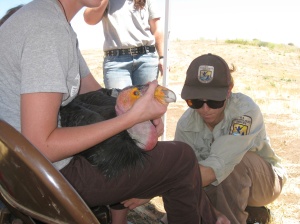Meet the Science Team: Carolyn Kurle
I was brought onto the condor project by my collaborator and friend Dr. Myra Finkelstein to help decipher potential variations in California condor diets among the flocks in central and southern California. Up until then, I had only seen live California condors at the Santa Barbara Zoo and stuffed condors in a diorama at the Santa Barbara Natural History Museum. When the opportunity arose for me to join the US Fish and Wildlife Service for their summer condor round up and bird examination in summer 2011, I jumped at the chance.
My son Jeremiah was four years old at the time and he and my husband Christian had already accompanied me on several field excursions related to my other projects, so I invited them along for three days at the Bitter Creek National Wildlife Refuge. We drove to their field site and met with the scientists who would be rounding up the birds for health monitoring, testing for lead poisoning, and blood sampling and drove to the condor pen. It was over 100 degrees, so very hot and somewhat desolate, but beautiful.
My job was minimal – watch the USFWS personnel catch the condors from the capture pen, label the blood collection vials and hand them to the scientists drawing blood, and keep my blood samples cold in a small cooler I had brought along for sample transport. I would spin the blood in a centrifuge later, back at our hotel, to separate the red blood cells from the plasma portion of the blood. I would later prepare these samples for stable carbon and nitrogen isotope analysis in my lab at the University of California San Diego. I then combined these data with isotope data from blood samples previously collected from these southern California condors and from birds in the central California flock to better understand potential dietary differences between the flocks and how these diet differences affect the health and well-being of the condors.
The most amazing things about being up close to California condors were their incredible size and their overwhelmingly ugly-but-beautiful faces. It’s one thing to know that condors are the largest terrestrial bird in North America, with wingspans that range to three meters, but it’s another thing to actually see these birds up close and truly understand what such a large size really means. And, up close, their faces are so incredibly fierce and intimidating, that one can clearly see they share a common ancestor with dinosaurs. These birds look dangerous, but they were very mellow to handle and the USFWS personnel did an excellent job processing each bird. I have worked with many animals species in my work as a food web ecologist, but the condors are definitely one of my favorites. Especially because I got to share the experience with my young son.
Dr. Carolyn Kurle and her then 4 year old son Jeremiah getting their first glimpse of free-flying California condors at the USFWS capturing pen in summer 2011 at the Bitter Creek National Wildlife Refuge in Southern California.

The incredibly large wingspan of a California condor.
Dr. Kurle and her son organizing blood samples and preparing tubes for blood collection.
The beautifully “ugly” face of the California condor.




Recent Comments